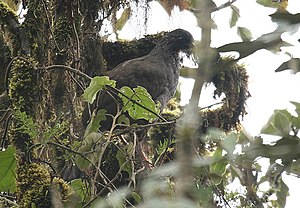Andenguan
| Andenguan | ||||||||||
|---|---|---|---|---|---|---|---|---|---|---|

Andenguan ( Penelope montagnii ) |
||||||||||
| Systematics | ||||||||||
|
||||||||||
| Scientific name | ||||||||||
| Penelope montagnii | ||||||||||
| ( Bonaparte , 1856) |
The Andenguan ( Penelope montagnii ) is a fowl from the family of the Hokko chickens (Cracidae).
The Latin additional species refers to Camille Montagne .
The bird is the most common and relatively widespread guan in the Andes , it occurs from Venezuela , Colombia via Ecuador and Peru south to Bolivia and possibly even in the extreme northwest of Argentina .
The distribution area includes higher (from 1500 to 3500 m) subtropical and temperate forests and forest edges, often dense, moist and rich in epiphytes .
The species is sympatric with the paler colored Bindenschwanzguan ( Penelope argyrotis on).
features
The bird is 51 to 61 cm tall and weighs between 818 and 840 g. He is stocky, less slender than most of the others in the genus Penelope. He has a small reddish brown dewlap and a lot of reddish brown on the rump. The beak has a white tip, the legs are reddish. The throat and tarsus are partly covered with feathers, as in the Bearded Guan ( Penelope barbata ). The species differs from this by its uniformly colored tail. There is no difference between the sexes . Fledglings are more brownish with indistinct white markings on the underside and paler on the sides of the head and on the throat.
voice
The call of the male appears as a monotonous, individually repeated, louder and faster sound as well as "chaah-choah-cha-cha-choam-cha-cha-cha ..." or a gentle "cluir cluir lui lui luir" in the twilight described.
Way of life
The breeding season is not exactly known. The nest is built from twigs and lined with leaves. The clutch consists of two eggs.
nutrition
The food consists mainly of fruits , but also plant seeds and leaves, which are usually looked for in groups in the trees.
Geographic variation
The following subspecies are recognized:
- P. m. atrogularis ( Hellmayr & Conover ) - Southwest Colombia, West Ecuador
- P. m. brooki ( Charles Chubb , 1917) - Southern Colombia, Eastern Ecuador
- P. m. montagnii ( Bonaparte ) 1856, nominate form - northern and central Colombia , northwest Venezuela
- P. m. plumosa ( Berlepsch & Stolzmann , 1902) - Peru
- P. m. sclateri ( GR Gray , 1860) - Bolivia
Hazardous situation
The population is not considered to be endangered ( Least Concern ), but it is threatened by habitat loss and hunting pressure.
literature
- C. Bonaparte: Tableaux paralléliques de l'ordre des Gallinacés. In: Comptes rendus hebdomadaires des séances de l'Académie des sciences . Vol. 42, 1856, p. 875, Biodiversity Library
Web links
- Oiseaux (French)
Individual evidence
- ^ Andenguan , in Avibase - The World Bird Database. Retrieved May 9, 2020.
- ↑ James A. Jobling: A Dictionary of Scientific Bird Names. Oxford University Press, 1991, ISBN 0-19-854634-3 .
- ↑ a b c d M. McMullan: Field Guide to the Birds of Colombia Rey Naranjo Editores, 2018, ISBN 978-958-8969-77-0
- ↑ a b c d e f del Hoyo, J. and GM Kirwan (2020): Andean Guan (Penelope montagnii), version 1.0. In: J. del Hoyo, A. Elliott, J. Sargatal, DA Christie, and E. de Juana (Eds.): Birds of the World . Cornell Lab of Ornithology, Ithaca, NY, USA 2020. [1]
- ↑ IOC World Bird List Megapodes, guans, guineafowl, New World quail
- ↑ Redlist.Retrieved May 8, 2020.